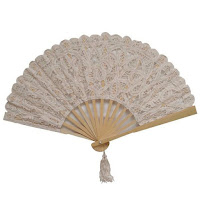Women's Accessories
(continued)
Fans
The way women used fans back in the 1700's, is fascinating to me. Women used fans as a form of communication. They could flirt, scold, express interest or disinterest and more. Certain movements of the fan could speak volumes to anyone who could speak the language.
"The 18th century was the heyday of the fan. It was an essential accessory in a stuffy, crowded ballroom. Fans were made in every medium: ivory, painted silk and paper, lace, chicken skin (a very fine kid) and so forth.
Young ladies were therefore instructed on the proper ways to handle their fan. For example, Matthew Towle’s Young Gentleman and Lady’s Private Tutor (1770) devoted several pages to the subject, and portraits of the period show ladies holding their fans in one or other of Towle’s recommended positions.
But 18th century ladies used the fan for more than keeping cool: they used it as a form of expression. More than any other article of fashion, the fan became part of a lady’s body language. Supposedly, there even existed a ‘language of the fan’ whereby ladies could send messages across a room without saying a word. To use this language, it was essential to know your right from your left! For example:
Touching right cheek – yes
Touching left cheek – no
Twirling in left hand – we are watched
Twirling in right hand – I love another
Fanning slowly – I am married
Fanning quickly – I am engaged
Open and shut – you are cruel
Open wide – wait for me
Presented shut – do you love me?
With handle to lip – Kiss me
In right hand in front of face – Follow me
Drawing across the cheek – I love you
Placing on left ear – I wish to get rid of you
Twirling in right hand – I love another
The Art of Dancing, Soame Jenyns
What daring bard shall e’er attempt to tell
The powers that in this little engine dwell?
What verse can e’er explain its various parts
Its numerous uses, motions, charms and arts?
Its shake triumphant, its virtuous clap,
Its angry flutter, and its wanton tap."
Ivory fan with vellum leaf - 'Return from Abroad'
c. 1740
Folding fan with ivory sticks (probably Chinese) and printed paper leaf published by Martha Gamble English, c. 1740
The two fans above, can be found at the Fan Museum in Greenwich, London.
Here's a few more beautiful fans:
Jewelry
If a person had the means to own jewelry or simply jewels, they could be used in many ways. Such as, weaved in a hairdo or clothing, on fans, reticules, buckles, etc. Of course there is the more expected places, on a brooch, ring, necklace etc. I had a really hard time narrowing this down for you, since there are so many gorgeous pieces to choose from, but here are some of my favorite period pieces.
Gloves
"As a consequence of technical advances and new forms of fashionable dress, the consumption of fabric and knitted gloves began to increase during the eighteenth century. The lower cost of these materials meant that gloves soon became accessible to a wider section of the populace. Changing fashions, along with the high cost of elaborate gauntlet styles, led to the emergence of shorter, wrist-length gloves. Such styles were often constructed of finely embroidered and printed leather or multicolored woven cloth. Gloves of this type were designed to complement the popular fashions of long ruffled or lace-trimmed sleeves."
Well, that's all I have for this week. What accessories are your favorites? I don't know if I could choose just one! I know I loved the chatelaines from last week and the jewelry this week. Comment if you have a favorite.
Thanks again for coming! Remember October 7th should be my last post for this series, so don't miss it. I'm looking forward to going to the ACFW Conference next week. Remember to subscribe here or at my website to get my newsletter in October. I'll try to update y'all on the conference and a few other things that have been going on there.
Have a great week! May the Lord God bless you and your family with faith, hope and love. In Jesus' Name.
In Christ,
Sandy





























































